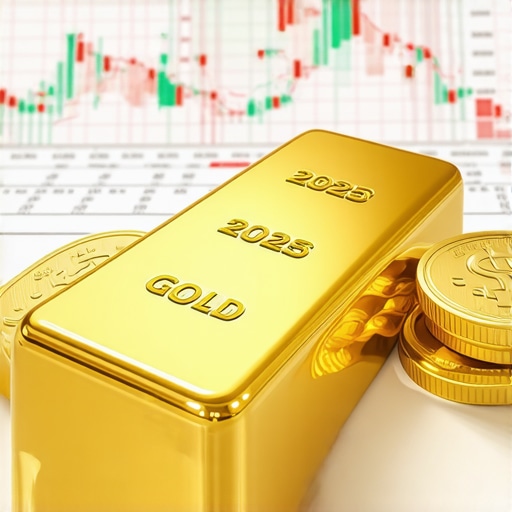When Gold Beckons: The Allure and the Risks of Physical Investment
Gold, that timeless symbol of wealth and security, has a magnetic pull on investors, especially in turbulent times. But as any seasoned investor will tell you, diving into physical gold isn’t just about grabbing shiny coins or bars off the shelf. It’s an art — a dance with authenticity, security, and timing.
Step One: Know Your Gold Before You Buy — Because Not All That Glitters Is Pure
Physical gold investment starts with education. Understanding karats, purity levels, and hallmark certifications isn’t just jargon; it’s your shield against counterfeits and overpaying. Whether you lean towards elegantly minted coins or hefty bars, knowing the difference is crucial. Curious about whether to choose bars or coins? That’s a whole conversation about liquidity and premiums worth exploring.
Step Two: Choose Trusted Dealers — Your Safety Net in the Glittering Market
Here’s a nugget of wisdom: your gold is only as safe as the hands you buy it from. The market is peppered with dealers, but only a fraction are genuinely trustworthy. Look for transparent pricing, solid reputations, and excellent customer reviews. For an in-depth guide on vetting dealers, this resource is indispensable.
Is It Really Safe to Keep Your Gold at Home?
Stashing your gold under the mattress might feel like a spy thriller cliché, but is it a wise security strategy? The truth is, physical gold demands responsible storage solutions—think bank safety deposit boxes or professional vault services. Home safes, if chosen wisely and installed discreetly, can also do the trick. It’s a balancing act between convenience and security.
Step Three: Verify Authenticity — Because Your Investment Deserves the Real Deal
Authenticity checks are the gatekeepers of smart physical gold investing. Techniques like acid tests, electronic gold testers, and x-ray fluorescence machines are not just for jewelers. Many savvy investors learn the ropes or rely on trusted experts to confirm their gold’s legitimacy. This step isn’t optional; it’s essential.
Step Four: Understand Market Dynamics — Timing Is (Almost) Everything
Gold prices dance to a complex rhythm influenced by inflation fears, central bank purchases, geopolitical tensions, and market sentiment. Keeping an eye on these trends can mean the difference between a smart buy and a regrettable splurge. For a deeper dive into how central banks move the gold market, check out this analysis.
Step Five: Diversify Your Approach — Because Even Gold Can Benefit from a Portfolio Mix
While physical gold is a solid pillar, pairing it with gold ETFs, stocks, or mutual funds can smooth out volatility and offer liquidity. Wondering how to balance bars and ETFs? The discussion on different gold investment types sheds light on crafting a resilient portfolio.
Speaking of resilience, did you know that historically, gold has acted as a robust hedge against inflation? For those curious about the nuances, the article on gold as an inflation hedge is a treasure trove of insights.
In the wise words of the World Gold Council, “Physical gold remains a trusted store of value and continues to be a vital part of investment portfolios worldwide.” Investing in physical gold safely isn’t just about possession; it’s about knowledge, trust, and strategy (source).
There you have it — the essential steps to gold investment with a wink and a nod from someone who’s seen the market’s gleam and grit. What’s your take? Have you dipped your toes into the golden waters yet? Share your stories or questions below — let’s turn this into a golden conversation.
Step Six: Mastering the Art of Timing — When to Buy and When to Sell Physical Gold
While gold has long been regarded as a safe haven, timing your physical gold investments can significantly influence returns. Price volatility driven by macroeconomic factors such as interest rate fluctuations, currency strength, and geopolitical unrest requires investors to stay vigilant. Seasoned investors often track gold market trends and central bank activities to identify optimal entry and exit points. Remember, buying gold during market dips and selling during peaks helps maximize gains while minimizing risks.
Step Seven: Storage Innovations — Beyond Traditional Vaults to Modern Solutions
Security remains paramount in physical gold investment. While traditional bank safety deposit boxes offer peace of mind, emerging storage solutions such as insured private vaults and blockchain-verified storage services present new avenues. These modern custodians combine technology with security, enabling investors to verify ownership and reduce risks of theft or fraud. For those unwilling or unable to manage physical storage, allocated gold accounts through reputable dealers provide a hybrid approach between physical possession and institutional security.
How Can Emerging Technologies Transform Physical Gold Ownership and Security?
Could innovations like blockchain and smart contracts redefine the way investors own, trade, and secure physical gold? These technologies promise enhanced transparency, traceability, and decentralized verification that may reduce fraud and improve liquidity. For example, tokenized gold platforms allow investors to hold digital certificates backed by physical gold, merging convenience with tangible asset security. However, regulatory frameworks and market adoption are still evolving, warranting cautious optimism.
Delving deeper into these possibilities, the World Gold Council highlights the potential for technology to streamline gold transactions and ownership verification, emphasizing that integrating innovation must complement, not replace, trusted investment practices.
Step Eight: Navigating Tax Implications and Legal Considerations
Physical gold investment doesn’t exist in a vacuum; understanding the tax landscape and legal regulations is crucial. Different jurisdictions have varying rules on capital gains taxes, import/export restrictions, and reporting requirements. Ignorance here can lead to unexpected liabilities or legal complications. Engaging with a knowledgeable financial advisor or tax professional ensures compliance and strategic planning to optimize your gold portfolio’s after-tax returns.
Investors should also be aware of provenance and ethical sourcing to align with evolving global standards and personal values, which increasingly influence market demand and gold’s reputation.
Step Nine: Leveraging Gold’s Inflation Hedge with Strategic Allocations
Beyond physical possession, strategically allocating gold within a diversified portfolio can hedge against inflation and currency risks. Experts recommend balancing gold exposure relative to other assets based on individual risk tolerance and economic outlook. Detailed strategies can be found in best gold investment strategies for inflation, highlighting how gold complements stocks, bonds, and cash during economic uncertainty.
Understanding these nuanced allocations helps investors keep gold’s role as a stabilizing force while optimizing growth potential.
Have you experimented with combining physical gold and financial instruments in your portfolio? Share your insights or questions below to enrich our gold investment community’s knowledge.
Step Ten: Harnessing Blockchain and Tokenization — The Next Frontier in Physical Gold Investment
The integration of blockchain technology into physical gold investment is no longer a distant concept but an emergent reality reshaping ownership paradigms. Tokenization allows investors to hold digital tokens that represent fractional ownership of physical gold stored securely in audited vaults. This innovation bridges the liquidity gap traditionally associated with physical gold by enabling near-instantaneous transfers while maintaining a tangible asset backing.
Beyond liquidity, blockchain’s immutable ledger ensures transparency and traceability, reducing counterparty risks and fraud. However, investors must navigate regulatory ambiguities and carefully select platforms with robust security and compliance frameworks. The World Gold Council underscores the importance of combining technological advancements with established trust mechanisms to safeguard investor interests.
Moreover, smart contracts—self-executing agreements coded on the blockchain—can automate compliance, facilitate seamless transactions, and even trigger insurance claims in case of storage breaches. These capabilities herald a paradigm shift, where gold ownership is both verifiable and programmable, unlocking unprecedented flexibility.
What Are the Risks and Rewards of Investing in Tokenized Physical Gold?
While tokenized gold offers enhanced liquidity and transparency, it introduces nuanced risks. Custodial risk persists since physical gold backing the tokens must be securely stored and audited. Regulatory frameworks remain in flux, potentially impacting token legality and taxation. Additionally, technological vulnerabilities such as smart contract bugs or platform hacks require due diligence.
Conversely, tokenization democratizes gold ownership by lowering entry barriers and enabling fractional investments, thereby expanding market participation. It also facilitates portfolio diversification strategies that blend physical asset reliability with digital agility.
Step Eleven: Navigating Complex Taxation Frameworks — Expert Guidance for Physical Gold Investors
Tax treatment of physical gold varies widely across jurisdictions, with implications for acquisition, holding, and disposition. Capital gains tax, value-added tax (VAT), import duties, and reporting requirements can significantly impact net returns. For instance, in the United States, physical gold is classified as a collectible and subject to higher long-term capital gains rates, whereas in the European Union, VAT exemptions apply under certain conditions.
Given this complexity, proactive tax planning is indispensable. Collaborating with tax professionals familiar with precious metals ensures compliance with local laws and leverages potential exemptions or deferrals. Incorporating physical gold within tax-advantaged accounts where permissible can further optimize after-tax performance.
Additionally, ethical sourcing documentation may influence customs clearance and investor reputation. Transparency in provenance aligns with increasing regulatory scrutiny and socially responsible investing trends, reinforcing gold’s market integrity.
Step Twelve: Strategic Allocation Models — Balancing Physical Gold with Diversified Portfolios for Optimal Inflation Hedging
Advanced investors recognize that gold’s inflation-hedging capabilities are maximized within thoughtfully constructed portfolios. Quantitative models suggest allocations ranging from 5% to 15%, adjusted dynamically based on macroeconomic indicators such as real interest rates, inflation expectations, and geopolitical risk indices.
Integrating physical gold with financial instruments like gold ETFs, mining equities, and derivatives can calibrate exposure to suit risk tolerance and liquidity needs. For example, physical gold offers crisis resilience and permanence, while ETFs provide tradability and cost efficiency. Mining stocks, albeit more volatile, expose investors to operational leverage on gold prices.
Continuous portfolio monitoring and rebalancing are essential to maintain strategic targets, especially in volatile markets. Leveraging advanced analytics and scenario planning tools enables investors to anticipate inflationary shocks and adjust gold holdings accordingly.
For a comprehensive framework on portfolio allocation strategies that harness gold’s protective qualities, see best gold investment strategies for inflation.
By synthesizing emerging technology, tax expertise, and sophisticated allocation models, investors can elevate their physical gold investment approach from mere possession to strategic mastery.
What innovative strategies or challenges have you encountered in modern gold investing? Join the discussion below and deepen your mastery of this timeless asset.
Step Thirteen: Embracing Behavioral Finance — Why Investor Psychology Shapes Gold Market Moves
While gold’s intrinsic value is often hailed as timeless, the market ebbs and flows heavily influenced by human behavior. Understanding cognitive biases such as herd mentality, loss aversion, and confirmation bias can lend an edge to seasoned investors. Behavioral finance insights reveal why sudden gold price surges or dips sometimes defy fundamental data — driven instead by market sentiment swings or geopolitical anxieties. Incorporating psychological awareness helps investors avoid pitfalls like panic selling or overenthusiastic buying, aligning decisions with disciplined strategy rather than emotion.
For those interested in exploring how sentiment indicators impact gold’s short-term volatility, this analysis of gold market trends offers a nuanced perspective.
Step Fourteen: Integrating ESG Principles — Ethical Gold Investing in the Modern Era
Environmental, Social, and Governance (ESG) criteria have transcended traditional asset classes to influence gold investment decisions. Today’s conscientious investors scrutinize gold’s provenance, favoring suppliers committed to sustainable mining practices, fair labor standards, and community development. ESG integration not only aligns portfolios with personal values but also mitigates risks related to regulatory penalties and reputation damage. Leading funds now incorporate ESG-screened gold assets, reflecting a growing market segment that prizes transparency and responsibility.
Engaging with how gold acts as a hedge against inflation also highlights how ESG considerations can coexist with gold’s protective qualities.
Can Artificial Intelligence Revolutionize Gold Market Forecasting and Risk Management?
The advent of AI-driven analytics is reshaping how investors anticipate gold price movements and manage portfolio risk. Machine learning models ingest vast datasets — from macroeconomic indicators to social media sentiment — generating predictive insights unseen by traditional methods. These tools enhance timing precision, identify emerging market patterns, and flag anomalies that might signal shifts in demand or supply. However, reliance on AI requires caution due to model biases and the unpredictability of black swan events.
Industry leaders like the World Gold Council acknowledge AI’s potential while emphasizing the irreplaceable role of human expertise in interpreting complex gold market dynamics.
Step Fifteen: Cultivating a Global Perspective — How Geopolitical Shifts Recalibrate Gold’s Role
Gold’s historic reputation as a safe haven is profoundly shaped by geopolitical developments — from trade wars to currency realignments. Staying attuned to international relations, sanctions, and central bank policies is critical for anticipating demand surges or price corrections. For instance, unexpected shifts in major economies’ gold reserves can ripple through global markets, affecting liquidity and valuation.
Investors benefit from resources like in-depth analyses of central bank gold purchases that decode these macro forces to inform strategic positioning.
What innovative strategies or challenges have you encountered in modern gold investing? Share your thoughts and experiences below to enrich our collective mastery of this timeless asset. Dive deeper into expert strategies with our curated resources and keep your portfolio gleaming with insight.
Expert Insights & Advanced Considerations
Blockchain’s Transformative Role in Physical Gold Ownership
While traditional physical gold investment relies on tangible assets and secure storage, emerging blockchain technology introduces unprecedented transparency, traceability, and liquidity. Tokenization bridges the gap between digital convenience and physical backing, enabling fractional ownership and streamlined transfers. However, integrating this innovation requires balancing regulatory compliance with trust in custodial partners. Savvy investors should explore platforms that combine blockchain verification with established security protocols to maximize benefits while mitigating risks.
The Nuances of Tax Strategy Across Jurisdictions Can Make or Break Returns
Physical gold investors must navigate a complex patchwork of tax laws varying by country and sometimes by state or region. Capital gains tax treatments, VAT exemptions, and reporting obligations differ widely, influencing net profitability. Proactive engagement with tax professionals specialized in precious metals is not a luxury but a necessity for optimizing after-tax returns. Understanding nuances such as collectible classification or tax-advantaged accounts for gold holdings can unlock substantial strategic advantages.
Behavioral Finance Insights Amplify Investment Discipline in Volatile Markets
Gold’s price movements often defy pure fundamentals due to investor sentiment and cognitive biases like herd behavior or loss aversion. Recognizing these psychological drivers equips investors to avoid impulsive decisions during spikes or dips. Incorporating behavioral finance principles supports a disciplined approach that aligns with long-term strategy, enhancing resilience against market noise and emotional pitfalls.
Dynamic Allocation Models Enhance Gold’s Role as an Inflation Hedge
Static gold allocations can miss opportunities or expose portfolios to undue risk. Advanced investors employ quantitative models that adjust gold exposure between 5% and 15% based on evolving economic indicators such as real interest rates and geopolitical risk. Blending physical gold with ETFs and mining equities creates a calibrated, liquid portfolio that optimizes inflation protection without sacrificing growth potential.
Ethical and ESG Considerations Are Reshaping Gold Investment Norms
Modern gold investors increasingly prioritize responsible sourcing, environmental sustainability, and social governance. These factors influence supplier choice, portfolio composition, and market demand. Integrating ESG principles not only aligns with personal values but also anticipates regulatory trends and enhances reputational capital, making it an indispensable facet of contemporary gold investing.
Curated Expert Resources
World Gold Council – Investment Insights: A definitive authority offering comprehensive analysis on gold market dynamics, blockchain integration, and ESG trends, essential for staying ahead in physical gold investment (gold.org).
Physical Gold Investment Strategies: Bars vs Coins Explained: This resource provides nuanced guidance on choosing physical gold forms, balancing liquidity, premiums, and storage considerations (buyingoldnow.com).
Analyzing Central Bank Gold Purchases and Their Market Impact: Deep dive into how geopolitical shifts and institutional demand shape gold’s pricing and liquidity, vital for timing and strategic positioning (buyingoldnow.com).
Best Gold Investment Strategies to Hedge Inflation Risks: Offers quantitative models and portfolio construction techniques that optimize gold’s inflation-hedging capabilities through diversified assets (buyingoldnow.com).
Understanding Gold Demand Trends and Their Effect on Market Prices: This resource sheds light on supply-demand drivers, sentiment analysis, and emerging market forces influencing gold’s valuation (buyingoldnow.com).
Final Expert Perspective
Physical gold investment remains a cornerstone for wealth preservation, offering unmatched security and inflation protection. Yet, mastering this asset class demands more than possession—it requires a sophisticated blend of technological awareness, tax acumen, behavioral insight, and ethical consideration. By embracing blockchain innovations, navigating complex tax regimes, applying behavioral finance principles, and dynamically allocating within diversified portfolios, investors elevate their approach beyond mere acquisition to strategic mastery. For those ready to deepen their expertise, exploring advanced gold investment strategies and engaging with evolving market analyses will keep your portfolio resilient and responsive. Engage with fellow experts, share your insights, and continue refining your gold investment craft—because in this timeless market, knowledge truly is the most valuable asset.









